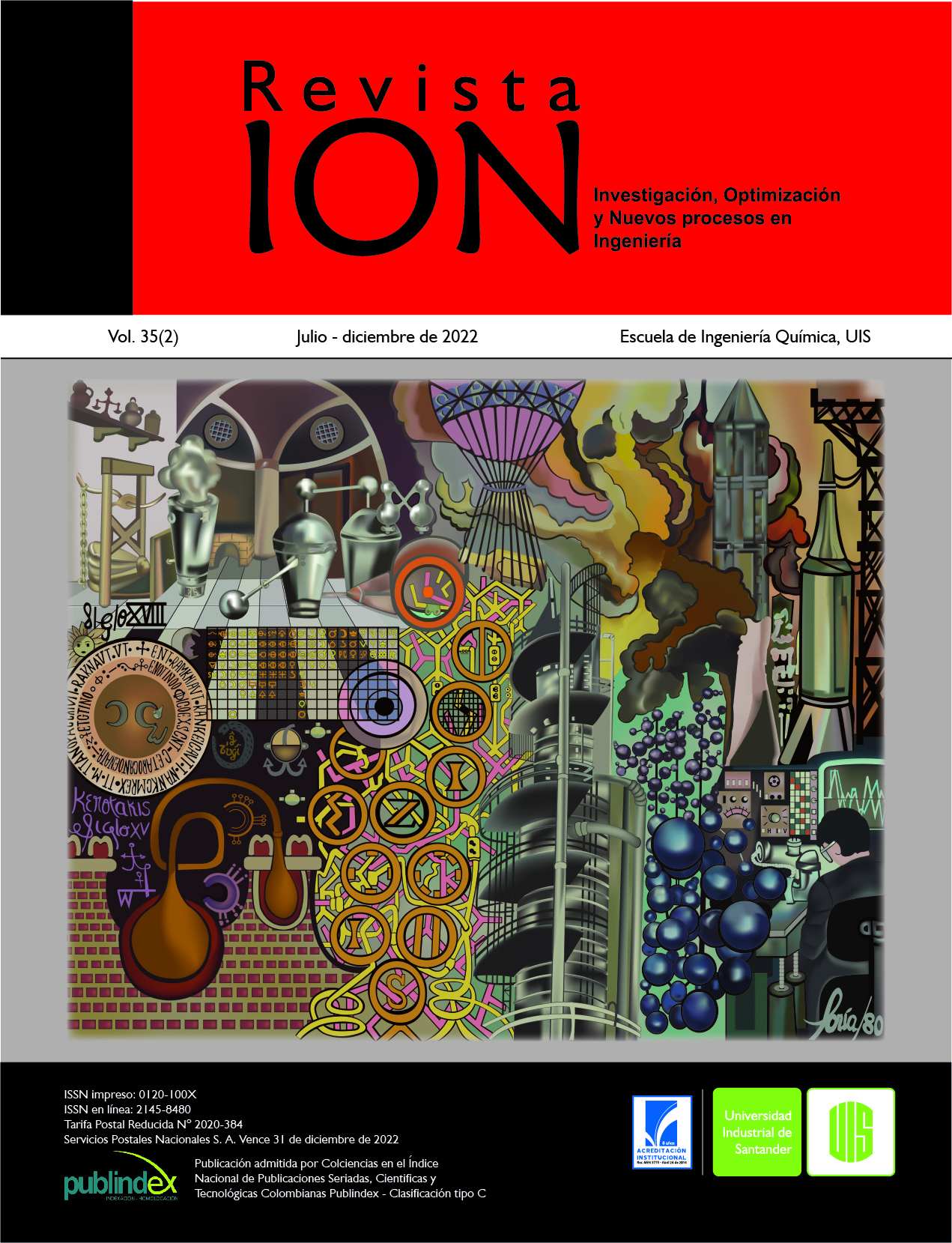Production of green concrete using rice husk ash and glass waste as substitutes for cement
Published 2022-12-05
Keywords
- Rice husk ash,
- Waste glass,
- Thermal conductivity,
- CO2 emissions,
- Pozzolans
How to Cite
Copyright (c) 2022 Oscar Felipe Arbeláez Pérez, Andrés Felipe Rúa Suárez, Jeferson Carvajal Jaramillo, Cristian Arley Lasso Cerón

This work is licensed under a Creative Commons Attribution 4.0 International License.
Abstract
In this work, waste glass (WG) were utilized as a pozzolanic material to improve the properties of rice husk ash concrete (RHA). Different RHA:WG mass ratio 1:0, 1:1, 1:2 and 1:3 (RHA + WG = 5%) as cement replacement were prepared. Slump, compressive strength, and CO2 emissions were evaluated. The results evidenced that the slump, density and compressive strength were higher than concrete prepared with rice husk ash. The highest relative compressive strength was observed in 3:1 concrete mixture. The CO2 emissions were reduced with the incorporation of rice husk ash and waste glass. The incorporation of WG in RHA concrete represents a good alternative for the disposal of these residues.
Downloads
References
- Islam MJ, Islam K, Shahjalal M, Khatun E, Islam S, Razzaque AB. Influence of different types of fibers on the mechanical properties of recycled waste aggregate concrete. Constr Build Mater. 2022;337:127577. doi.org/10.1016/j.conbuildmat.2022.127577
- Assawamartbunlue K, Surawattanawan P, Luknongbu, W. Specific energy consumption of cement in Thailand. Energy Procedia. 2019; 156, 212-216. doi.org/10.1016/j.egypro.2018.11.130
- Dey T, Bhattacharjee T, Nag P, Ritika, Ghati A, Kuila A. Valorization of agro-waste into value added products for sustainable development. Bioresour Technol Reports. 2021;16:100834. doi.org/10.1016/j.biteb.2021.100834
- Esmaeili J, Oudah Al-Mwanes A. A review: Properties of eco-friendly ultra-high-performance concrete incorporated with waste glass as a partial replacement for cement. Mater Today Proc. 2021;42:1958–65. doi.org/10.1016/j.matpr.2020.12.242
- Soliman NA, Tagnit-Hamou A. Development of ultra-high-performance concrete using glass powder – Towards ecofriendly concrete. Constr Build Mater. 2016;125:600–12. doi.org/10.1016/j.conbuildmat.2016.08.073
- Raju AS, Anand KB, Rakesh P. Partial replacement of Ordinary Portland cement by LCD glass powder in concrete. Mater Today Proc. 2019;46:5131–7. doi.org/10.1016/j.matpr.2020.10.661
- Jiang X, Xiao R, Bai Y, Huang B, Ma Y. Influence of waste glass powder as a supplementary cementitious material (SCM) on physical and mechanical properties of cement paste under high temperatures. J Clean Prod. 2022;340. doi.org/10.1016/j.jclepro.2022.130778
- Kamali M, Ghahremaninezhad A. Effect of glass powders on the mechanical and durability properties of cementitious materials. Constr Build Mater. 2015;98:407–16. doi.org/10.1016/j.conbuildmat.2015.06.010
- Rajendran R, Sathishkumar A, Perumal K, Pannirselvam N, Lingeshwaran N, Babu Madavarapu S. An experiment on concrete replacing binding material as waste glass powder. Mater Today Proc. 2021;47(15):5447–50. doi.org/10.1016/j.matpr.2021.06.431
- Kumar Das S, Adediran A, Rodrigue Kaze C, Mohammed Mustakim S, Leklou N. Production, characteristics, and utilization of rice husk ash in alkali activated materials: An overview of fresh and hardened state properties. Constr Build Mater. 2022;345:128341. doi.org/10.1016/j.conbuildmat.2022.128341
- Wu K, Han H, Rößler C, Xu L, Ludwig HM. Rice hush ash as supplementary cementitious material for calcium aluminate cement – Effects on strength and hydration. Constr Build Mater. 2021;302:124198. doi.org/10.1016/j.conbuildmat.2021.124198
- Khan R, Jabbar A, Ahmad I, Khan W, Khan AN, Mirza J. Reduction in environmental problems using rice-husk ash in concrete. Constr Build Mater. 2012;30:360–5. doi.org/10.1016/j.conbuildmat.2011.11.028
- Harihanandh M, Rajashekhar reddy K. Study on durability of concrete by using rice husk as partial replacement of cement. Mater Today Proc. 2022;52:1794–9. doi.org/10.1016/j.matpr.2021.11.448
- Camargo Pérez N, Higuera Sandoval C. Concreto Hidraulico Modificado con Silice obtenida de la cascarilla de arroz. Cienc e Ing Neogranadina. 2017;27:91–110. doi.org/http://dx.doi.org/10.18359/rcin.1907
- Adesina A. Recent advances in the concrete industry to reduce its carbon dioxide emissions. Environ Challenges 2020;1:100004. doi.org/10.1016/j.envc.2020.100004
- Alnahhal MF, Alengaram UJ, Jumaat MZ, Abutaha F, Alqedra MA, Nayaka RR. Assessment on engineering properties and CO2 emissions of recycled aggregate concrete incorporating waste products as supplements to Portland cement. J Clean Prod. 2018;203:822–35. doi.org/10.1016/j.jclepro.2018.08.292
- Santana-Carrillo JL, Burciaga-Díaz O, Escalante-Garcia JI. Blended limestone-Portland cement binders enhanced by waste glass based and commercial sodium silicate - Effect on properties and CO2 emissions. Cem Concr Compos. 2022;126:104364. doi.org/10.1016/j.cemconcomp.2021.104364
- Behera M, Rahman MR. Evaluating the combined effect of recycled aggregate and rice husk ash on concrete properties. Mater Today Proc. 2022;61:370–8. doi.org/10.1016/j.matpr.2021.10.127
- Siddika A, Mamun MA Al, Alyousef R, Mohammadhosseini H. State-of-the-art-review on rice husk ash: A supplementary cementitious material in concrete. J King Saud Univ - Eng Sci. 2021;33(5):294–307. doi.org/10.1016/j.jksues.2020.10.006
- Miller SA, Cunningham PR, Harvey JT. Rice-based ash in concrete: A review of past work and potential environmental sustainability. Resour Conserv Recycl. 2019;146:416–30. doi.org/10.1016/j.resconrec.2019.03.041
- Fapohunda C, Akinbile B, Shittu A. Structure and properties of mortar and concrete with rice husk ash as partial replacement of ordinary Portland cement – A review. Int J Sustain Built Environ. 2017;6(2):675–92. doi.org/10.1016/j.ijsbe.2017.07.004
- Ibrahim KIM. Recycled waste glass powder as a partial replacement of cement in concrete containing silica fume and fly ash. Case Stud Constr Mater. 2021;15:e00630. doi.org/10.1016/j.cscm.2021.e00630
- Bixapathi G, Saravanan M. Strength and durability of concrete using Rice Husk ash as a partial replacement of cement. Mater Today Proc. 2022;52:1606–10. doi.org/10.1016/j.matpr.2021.11.267
- Santhosh KG, Subhani SM, Bahurudeen A. Recycling of palm oil fuel ash and rice husk ash in the cleaner production of concrete. J Clean Prod. 2022;354:131736. doi.org/10.1016/j.jclepro.2022.131736
- Alsubari B, Shafigh P, Jumaat MZ. Utilization of high-volume treated palm oil fuel ash to produce sustainable self-compacting concrete. J Clean Prod. 2016;137:982–96. doi.org/10.1016/j.jclepro.2016.07.133
- Hanif A, Kim Y, Lu Z, Park C. Early-age behavior of recycled aggregate concrete under steam curing regime. J Clean Prod. 2017;152:103–14. doi.org/10.1016/j.jclepro.2017.03.107


